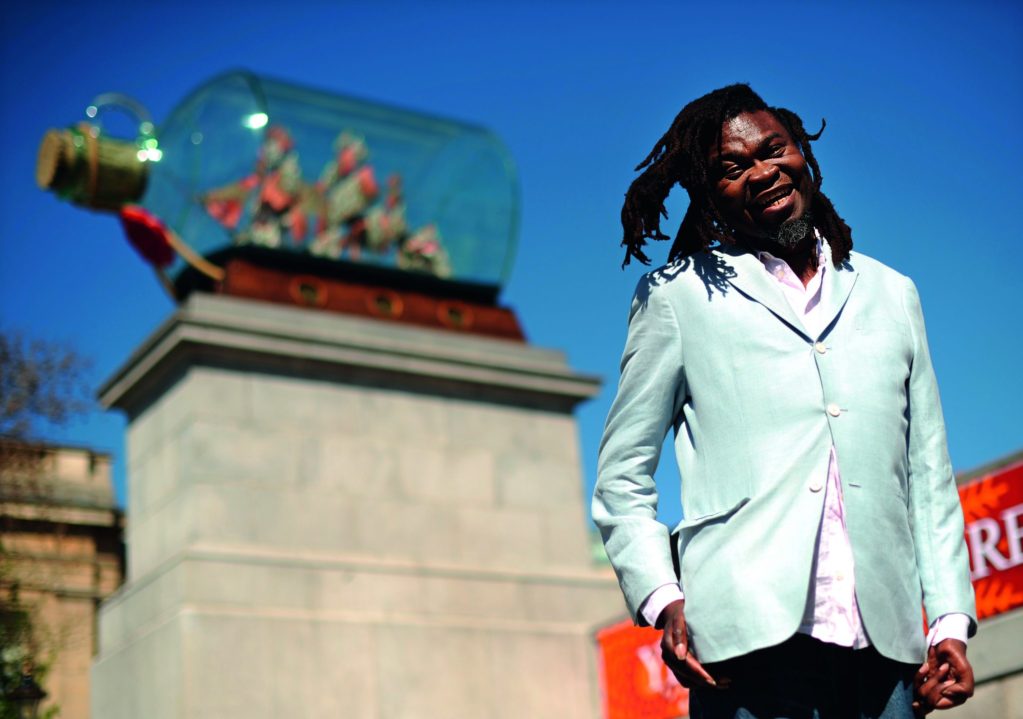Stacked plastic boxes of Dutch Wax, the colorful patterned fabric ubiquitous in West African communities, obstruct the cramped staircase of Yinka Shonibare’s studio, a converted warehouse in east London.
Now a signature of his work, the tangled history of the material encapsulates some of the themes central to the artist’s canon. Originally based on Indonesian batik printing techniques, the fabric was commercialized by Dutch and Belgian traders in the 19th century and sold on to West Africa in huge quantities. Since then, Chinese manufacturers have begun to capture large swathes of the market.
Dutch Wax is, like Shonibare himself, a cultural chimera, a combination of global influences. Born in the United Kingdom in 1962 to Nigerian parents, Shonibare moved to Lagos at the age of three and returned at 17 to complete his education. Today, his joyfully subversive work mixes quintessentially British iconography with African accents, taking aim at a broad range of domestic and international issues.
“My point is that identities are often made up of different influences from around the globe… no culture is actually static,” he says of his chosen material. “A lot of cultures actually take and reuse things. But there is a romantic wish to freeze culture in a sort of time warp. Even within the continent of Africa, no such thing [as stasis] actually existed within traditional cultures. People always incorporated and took on new things as part of a growing, dynamic, living culture.”

Artwork Homeless Man by Yinka Shonibare
Loading...
He is comfortable with the Nigerian-British or British-Nigerian labels he is routinely given. The world accepts “hyphenated identities” as does he.
“I have no wish to run away from my identity. I’m informed by history. I’ve been defined by a colonial encounter with Nigeria… So, I enthusiastically explore that historical fact in my work because to stand outside of it would be to delude myself. If I don’t define myself by it, then others will. So I might as well do it first.”
Shonibare resisted definition from an early stage. At art school in London during the last days of the Soviet Union, he began working on art that explored perestroika. His tutors, however, saw an African artist and with that, came preconceptions. He was asked, he says, why he was not producing “authentic” African art.
That was difficult, he says for “somebody who grew up in a cosmopolitan city like Lagos, watching Sesame Street on television. I don’t think people understand that here. They think Africa is still the jungle. It’s coming from that mentality and that’s why I thought I’ll give you ‘Africa’, but I’ll give you Africa with a twist.”
“At the time, I guess I was facing the world and trying to understand how I was perceived by it. I learned through that process that actually, as a black man in Europe, anonymity was rather difficult. Now things are different, but I think then, whatever I did, people would have said ‘that’s a black man who doesn’t make work about being black.’”
Shonibare’s reaction to this early pigeonholing created the signatures he uses to this day—British imagery remade. One set of photographs cast Shonibare himself as a Victorian dandy. Another of his most popular pieces—which had a long residency on the empty fourth plinth beneath Nelson’s Column in London’s Trafalgar Square—was a scale model of Admiral Nelson’s flagship HMS Victory: its sails made of Dutch Wax. The work is frequently playful, an ironic comment on aspects of European society and globalization through the eyes of someone with a “hyphenated” identity.
“I think for me, it’s just generally amusing. No-one ever questioned Picasso’s obsession with African clichés—why can’t I do the same to European culture? There was a fetishization of African culture by a lot of modernist European artists. So as an African artist now, I can do the same to European culture with a lot of amusement,” says Shonibare.
Post-colonialism and the colonial ties that link global Africans like Shonibare to Europe remain a major theme in his work. Unlike some of his contemporaries, however, he has avoided sliding into bleak assessments of the crushed optimism of early post-colonialism. The reason, once again, is his refusal to fall into line with preconceptions and labels.
“It’s extremely important not to be anybody’s victim. Power does not lie in victimhood, so you are more assertive if you are in control of your own image and your own culture. One group does not have a monopoly on aesthetic pleasure. Anyone has the power to express themselves in the way they want to. I dictate the terms of my own work,” he says.
In the same vein, he refuses to appear to be suffering for his art. Shonibare is wheelchair-bound after contracting Transverse Myelitis in his youth.
“I think what’s normally expected is some sort of sob story of the victim. That’s not the narrative I’m particularly interested in; especially where historically my people have been oppressed and disempowered. Why should I fall for another victim narrative, when I could actually take control of the means of production?”
“That sounds very Marxist,” he laughs. “The artist is meant to be some kind of van Gogh who will die with no money and suffer generally, but I actually think in 2012 that’s just old hat. It’s not interesting. You have to take control.”
Art, he says, has been a spiritually and commercially fulfilling career—although his father would still have preferred him to become a lawyer. It’s one that continues to provide new outlets for his musing on identity and culture. For the next five years, his latest work—a ballerina dressed in bright purple and green Dutch Wax fabric, will rotate in a glass bubble on the corner of the Royal Opera House in London’s Covent Garden. In August, he curated a major exhibition of African art and culture at the opera house, overseeing, among other performances, an African ensemble performing Handel’s Messiah in the heart of Britain’s cultural establishment.
Loading...
